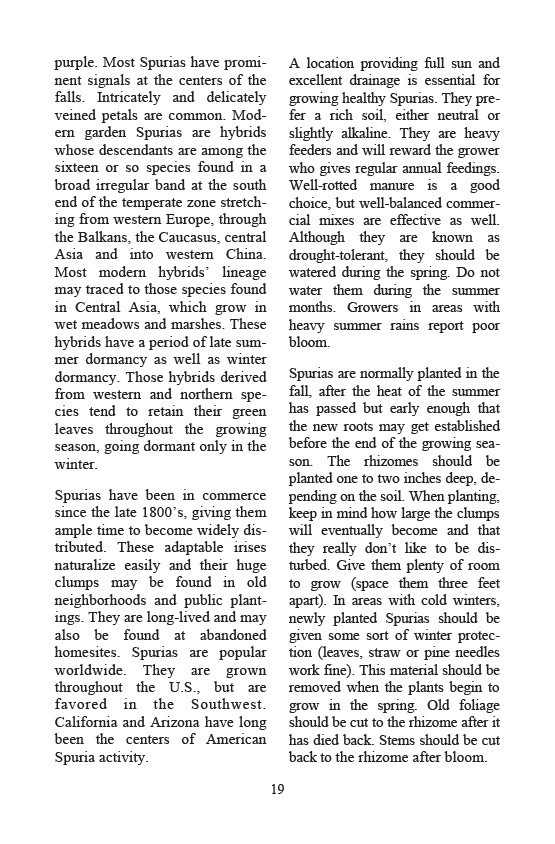
19
purple. Most Spurias have promi-nent
signals at the centers of the
falls. Intricately and delicately
veined petals are common. Mod-ern
garden Spurias are hybrids
whose descendants are among the
sixteen or so species found in a
broad irregular band at the south
end of the temperate zone stretch-ing
from western Europe, through
the Balkans, the Caucasus, central
Asia and into western China.
Most modern hybrids‟ lineage
may traced to those species found
in Central Asia, which grow in
wet meadows and marshes. These
hybrids have a period of late sum-mer
dormancy as well as winter
dormancy. Those hybrids derived
from western and northern spe-cies
tend to retain their green
leaves throughout the growing
season, going dormant only in the
winter.
Spurias have been in commerce
since the late 1800‟s, giving them
ample time to become widely dis-tributed.
These adaptable irises
naturalize easily and their huge
clumps may be found in old
neighborhoods and public plant-ings.
They are long-lived and may
also be found at abandoned
homesites. Spurias are popular
worldwide. They are grown
throughout the U.S., but are
favored in the Southwest.
California and Arizona have long
been the centers of American
Spuria activity.
A location providing full sun and
excellent drainage is essential for
growing healthy Spurias. They pre-fer
a rich soil, either neutral or
slightly alkaline. They are heavy
feeders and will reward the grower
who gives regular annual feedings.
Well-rotted manure is a good
choice, but well-balanced commer-cial
mixes are effective as well.
Although they are known as
drought-tolerant, they should be
watered during the spring. Do not
water them during the summer
months. Growers in areas with
heavy summer rains report poor
bloom.
Spurias are normally planted in the
fall, after the heat of the summer
has passed but early enough that
the new roots may get established
before the end of the growing sea-son.
The rhizomes should be
planted one to two inches deep, de-pending
on the soil. When planting,
keep in mind how large the clumps
will eventually become and that
they really don‟t like to be dis-turbed.
Give them plenty of room
to grow (space them three feet
apart). In areas with cold winters,
newly planted Spurias should be
given some sort of winter protec-tion
(leaves, straw or pine needles
work fine). This material should be
removed when the plants begin to
grow in the spring. Old foliage
should be cut to the rhizome after it
has died back. Stems should be cut
back to the rhizome after bloom.